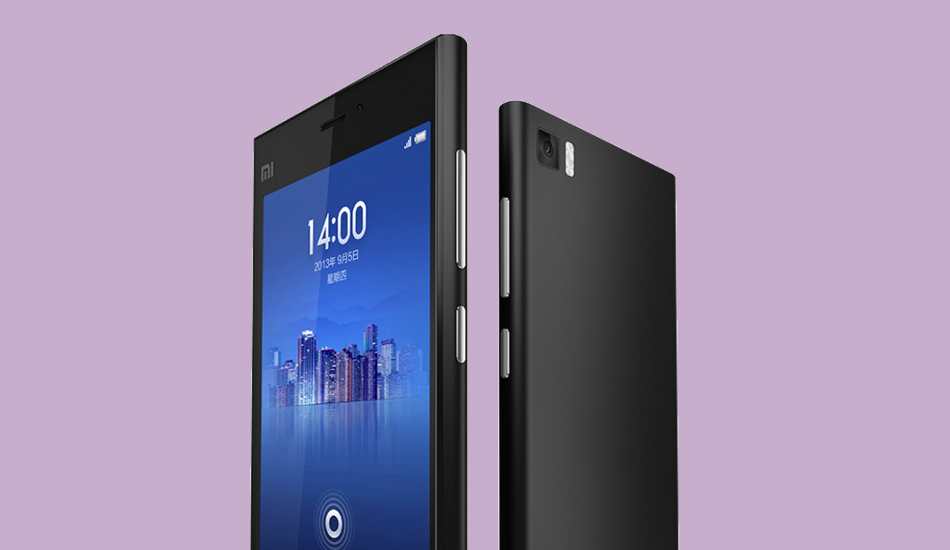Xiaomi has announced the new Mi3 smartphone with top of the line hardware, attractive design and mind-blowing price. No exaggeration but we really think that the Mi3 is certainly going to shake the competition. Loaded with a 5-inch Full HD display, the Mi3 packs quad-core Qualcomm Snapdragon 800 mobile Chipset – the same one found in handsets costing higher than Rs 35,000. Xiaomi has priced the Mi3 at Rs 14,999 in India.
At that price point, the only handset which can probably come close with sort of identical hardware – Karbonn Titanium Hexa. Priced at Rs 14,990 roughly, the Titanium Hexa comes close to give competition to the new Xiaomi Mi3.
We shall take closer look at both the smartphones to highlight the similar areas and the ones where they stand poles apart.
Design
Xiaomi Mi3 offers a very simple flat-like design with curved sides and flat top as well as bottom. In a way, it reminds us of the early Nokia Lumia 800 based iteration. The Mi3 is merely 8.1 mm thick and weighs 145 grams heavy. Available only in Metallic Gray, the Mi3 does come with very premium finishing and look.
Karbonn Titanium Hexa is 6.9 mm thick and its metallic accent gives it a premium look. The placement of its rear camera is slightly different – on the left side. Even this phone has three capacitive menu buttons in the front.
Presence of capacitive menu buttons is a bleak reminder of the uncertainty of these devices getting the next major Android L updates. Unless both companies think otherwise.
Karbonn Titanium Hexa continues to be the slim hexa-core smartphone however, the Mi3 tries to win with simpler look and premium feel.
Hardware
Xiaomi has carefully selected the hardware to deliver the best possible performance through its MIUI version. The Mi3 handset features a 5-inch IPS LCD display with 1920×1080 pixel resolution. Apart from great viewing angles, the display pushes pixel density of 441 pixels per inch and also supports multi-touch. Xiaomi has powered this handset with quad-core 2.3 GHz Qualcomm Snapdragon 800 mobile chipset coupled with Adreno 330 GPU graphics. The Mi3 features 2 GB RAM to deliver best memory Bandwidth to easily run the operating system and the apps. By default, the Mi3 will be sold with only 16 GB on-board storage and there is no Memory card slot. The company has not given any clarity on whether the 64 GB version will be introduced in India or not.
Karbonn Titanium Hexa features a 5.5-inch display with 1920×1080 pixel resolution support and thus pushes pixel density of 401 pixels per inch. Karbonn has powered the Titanium Hexa with hexa-core 1.5 GHz MediaTek MT6591 mobile chipset. Karbonn has armed it with 2 GB RAM to power the mobile OS and run the apps smoothly. Apart from 16 GB on-board storage, Hexa offers a Memory card slot to expand the storage. The Hexa is also a Dual-SIM smartphone supporting one 3G network SIM.
The Mi3 offers Dual-Band WiFi 802.11 a/b/g/n/ac, promising high speed mobile internet experience and downloads. On the other hand, the Hexa offers WiFi 802.11 b/g/n standard with single-band only support.
Both offer Bluetooth 4.0 support while only Mi3 has added A2DP support for easily pairing a headset to listen to music. Both offer GPS with A-GPS support but Mi3 packs the GLONASS support as well powered by Qualcomm chip to ensure faster and more accurate location locking. Both offer USB on-the-go support when used with USB OTG cable.
In the grounds of hardware, the Mi3 is ahead by leaps and bounds compared to the Titanium Hexa.
Software
Both smartphones arrive with the Android 4.4 KitKat. In past, both companies have performed minimal skinning on the top of the Android. Xiaomi has used MIUI version 5 user interface to deliver a different and custom look. While we expect bunch of pre-loaded system apps for file management, power management and other purposes. Xiaomi is more likely to deliver the next major Android update whenever it is released.
Camera
Both smartphones feature 13 Megapixel camera at the back. However, only Mi3 offers Dual-LED flash with Autofocus while the Hexa features a single LED flash with autofocus. Camera apps of both phones are loaded with fancy features such as HDR, Panorama, Face Detection and so on. Both devices are capable of recording full 1080p videos.
Xiaomi has placed a 2 megapixel camera in the front of Mi3 that can record full HD videos as well. Meanwhile, the Titanium Hexa features 5 megapixel camera for better imaging results.
Both smartphones offer similar imaging hardware and only real world testing can reveal the true winner.
Battery
One of the most important feature of a smartphone is a battery. Karbonn has crammed a 2050 mAh battery in its dual-SIM Titanium Hexa and one can expect at least a day long run time. Xiaomi Mi3 has a much better 3050 mAh battery. As the figures suggest, Mi3 is expected to have longer run time than the Titanium Hexa.
Final Words
Karbonn is currently offering the Titanium Hexa at Rs 14,990 since last three months. The new Xiaomi Mi3 is priced at Rs 14,999. One can only be greedy to ask for more at such a price. Of course, the short of storage space on Mi3 might pinch the ones who love to load the phone but seldom use it. On the specifications ground, Xiaomi Mi3 certainly is the unsung king handset in the Rs 15,000 segment.


